I recently got an e-mail from a Jeeper, FrankT, who uses my site and frequents some of the same forums I do. He had recently done a ball joint replacement on a high pinion Dana 30 axle that he was prepping for a swap into his TJ. He noticed that I didn’t have a ball joint write-up on the site and so volunteered his photos and text. While I was planning on doing some ball joint work later this year, I couldn’t pass up these good photos and Frank’s comments so here they are. A big thanks goes out to Frank for sharing his information with us. I’m sure many will benefit from it…..and I’ll be referring to it when I get ready to replace mine!
So….here is Frank’s pics and comments on his D30 ball joint replacement.
I just swapped in a HP30 and I wasn’t going to rely on the 10 year old ball joints. I also wasn’t going to swap over the 7 year old ball joints on my current housing so I did the only viable option, I installed new ball joints. Now, I apologize because I removed the ball joints a while ago and did not snap any pics. However, I just did a mock setup on my old housing to demonstrate how to remove them.
So, lets get started.
I would recommend doing this one side at a time; leaving the other side intact as a reference. Unfortunately all of my pics were taken during my axle swap. First, you will need to loosen the lug nuts, jack up the jeep, and then remove the tires. I prefer to support the Jeep via the frame since I will be messing with the axle itself. Better yet, put some jack stands underneath the frame and the axle. Once the tires are off, you will need to pull the brake calipers by removing the two 13mm bolts and tie them up. Next, remove the rotors and place them to the side. Oh, and don’t forget to drain the gear oil.
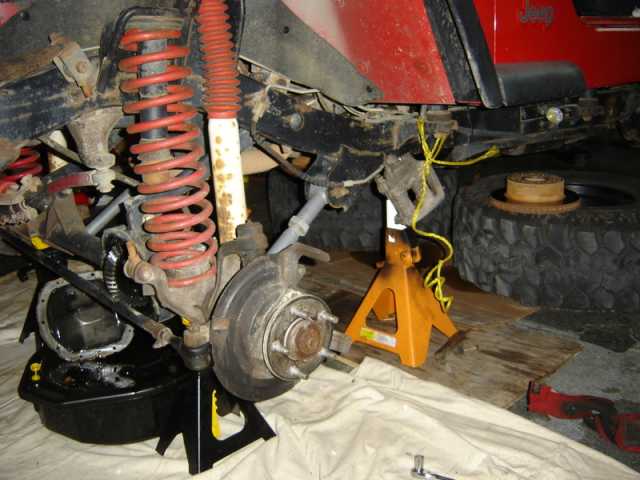
Then get your 12pt 13mm socket and remove the three bolts that clamp the hub to the knuckle.
BTW, here is a useful link with some additional and helpful information.
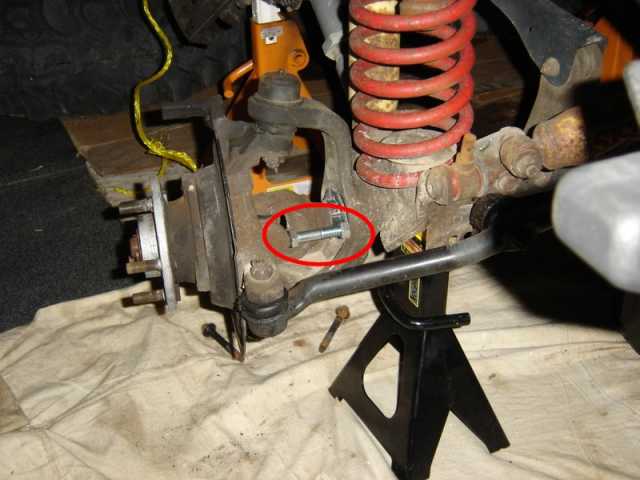
Now, this is a real slick little trick devised by mrblaine. I cannot even explain how easy this hub removal method is, but you have to trust me. I used to beat on the hub with three long scrap bolts until I got the knuckle out, HA! Go to the hardware store and get a 2-1/2″ long bolt and nut. Place it between the outer axle shaft ear and the axle housing as shown above.
A helper would be a good idea here as he or she can turn the steering wheel so you can get the bolt in there tight enough. Once it’s in place, turn the steering wheel accordingly and the hub will honestly just pop right out. Its really an amazing trick. My hubs haven’t been removed in 7 years in the rust belt and they just came right out. You can see my “puller” just fell to the floor once the hub was released.

(Stu comment: A short write-up showing Blaine’s technique for this easy hub removal can be found here on this site.)
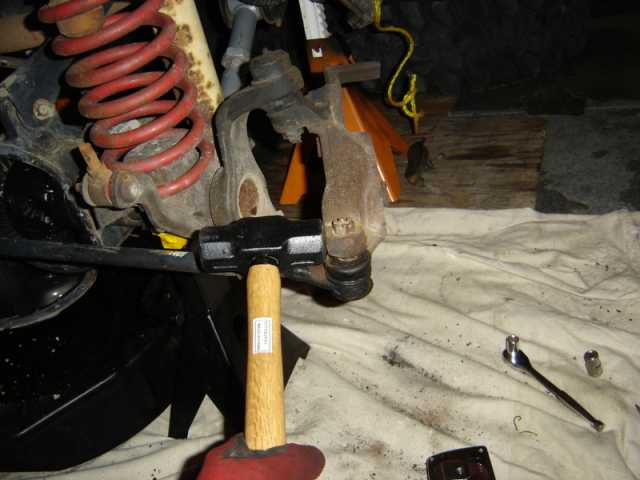
Now, you will need to get your TRE puller a BFH. Remove the cotter pins thru the TRE and the loosen the castle nut until it has a couple threads engaged. Hit the side of the steering arm on the knuckle a couple times, and it’ll pop right out.
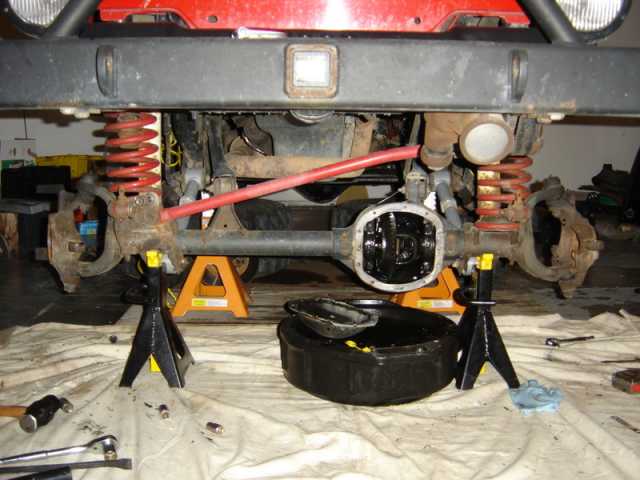
Finish removing the castle nut and take the TRE out of the knuckle and tie it up. I was doing a front axle swap so I removed everything which you can see in the picture.
Now, you will need to remove the knuckle. Once again, there are some cotter pins which need to be removed. If you had fun the first time, get ready for some more fun this time around. Living around here they tend to rust in place and I haven’t figured out a good trick yet. Once the cotter pins are removed, you can loosen the castle nuts. I think the upper ball joint castle nut is 7/8″ and the lower in 1-5/16″. I opt to leave the nuts engaged a few threads for the knuckle removal just like the TREs.
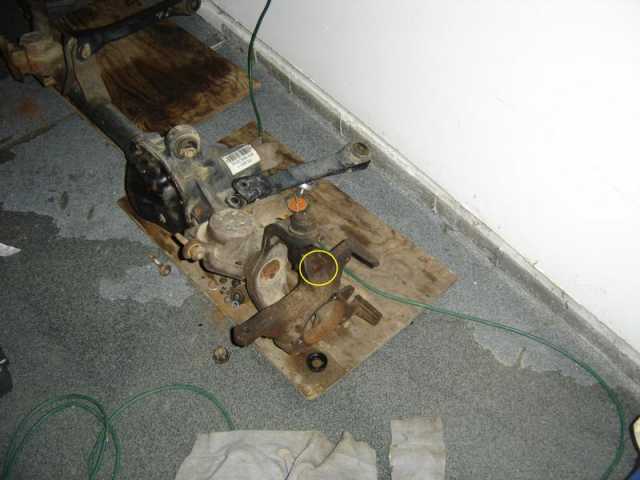
To remove these, you will have to give them a few good whacks. There is a small “shelf” cast into the knuckle (circled in yellow in the above photo) that provides a good place for the hammer to strike.
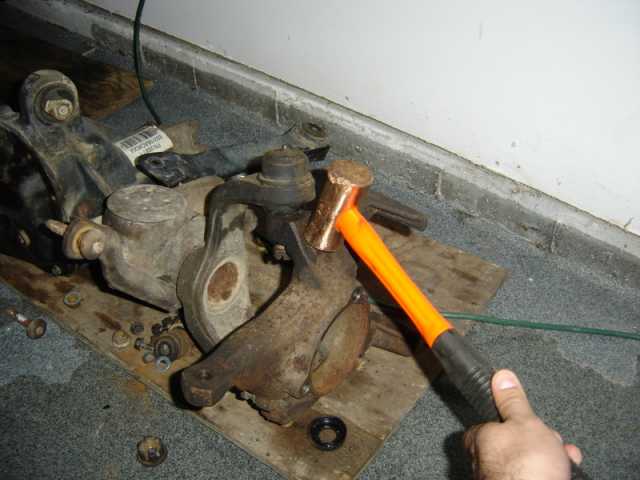
Finally, the axle will look something like this.
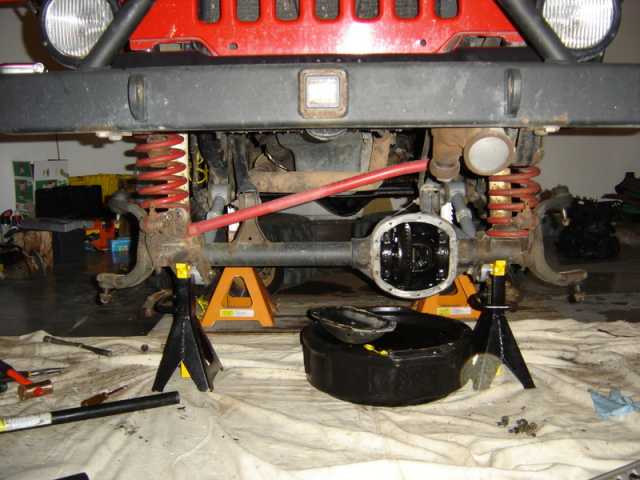
Once again, I would suggest doing this one side at a time so if anything goes wrong; you can use the other side as a reference. My project involved swapping axles, so I was removing everything at one time.
Now its time to remove the old ball joints from the axle. As I mentioned, I failed to snap pics when I removed them from my HP30, but I setup the ball joint press on my old axle to show you how it will look. If I were you, I would just rent a suitable ball joint press from Autozone. However, I like to buy tools; they are like my big boy toys so I purchased a good quality ball joint press. Do not rely on a harbor freight u-joint tool, it might look the same, but I have heard they have a tendency of bending.
(Stu comment: What Frank said is very true….the HF tool is NOT up to this job!)

Here is mine, OTC PN: 7249 with the optional adapters for Jeep 4wd vehicles (PN: 7894). I�m not sure if the adapters are necessary, but they definitely work great. You can see the MADE IN USA sticker, that’s what you are looking for IMO.
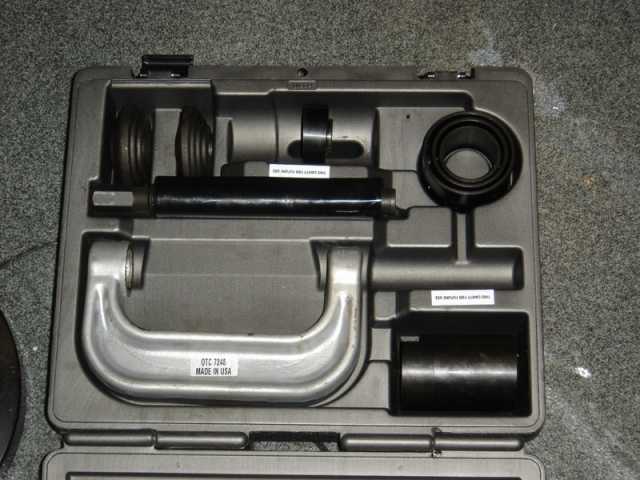
(Stu comment: The adapters are virtually a must have, in my opinion. They compensate for the odd angle that the TJ’s ball joints are mounted at.)
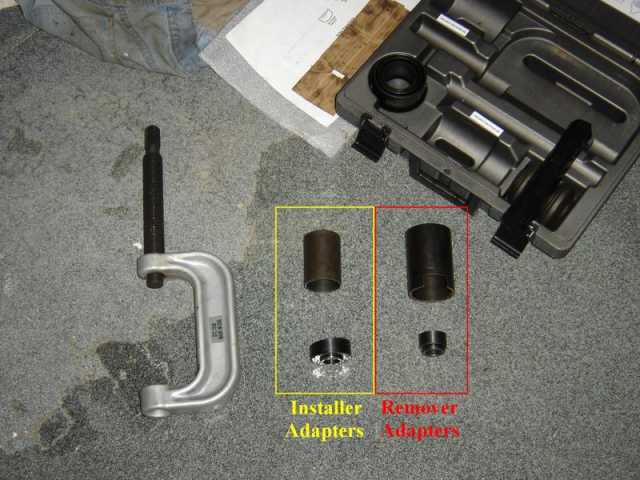
Shown here are the press and the Jeep/Dodge adapters.
D30 Ball Joint Replacement

It’s pretty much simple stuff from here on out. Just follow the directions that came with the ball joint press; although the adapters really only fit in the press one way, so it’s pretty much a no-brainer. This is what the press will look like with the adapters in place to remove the upper ball joint.
Start tightening the press down with a breaker bar until the ball joint pops out of place. It will literally snap once it breaks loose, but don’t worry, it’s not going anywhere. Keep tightening the press until the ball joint is fully removed. Loosen the press and remove everything.
For the lower ball joint you can devise a plan the go through the upper ball joint hole, or else you can jack up the axle and put the press in upside down. I do not have a pic, but its pretty much exactly the same setup as the upper ball joint, just turn the press upside down
Ok, so now the ball joints are removed and you are ready to re-install some shiny new ones. I opted for some regular Spicer ball joints, but some people prefer the Moog joints. Choose wisely. I do everything in the opposite order and just use the installing adapters. Before I start, I like to mock everything up and make sure I know how its all going to fit. Install the lower ball joint first since the axle should still be high enough to put the press upside down. This allowed me to use the adapters as intended with no extra pieces. Line up the ball joint into the inner C, and assemble the press as shown. You will see the press is in line with the angle of the inner C; that’s courtesy of the specific adapters for the Jeep application. The installer cup is angled keeping the press applying pressure in the proper direction so the ball joint does not bind. The ball joint goes in fairly smooth until the last inch or so. If it’s not going in easily, there might be something wrong. Stop! Remove the press, look at the ball joint to see if it’s going in on an angle, then make sure the press is in line and try again.
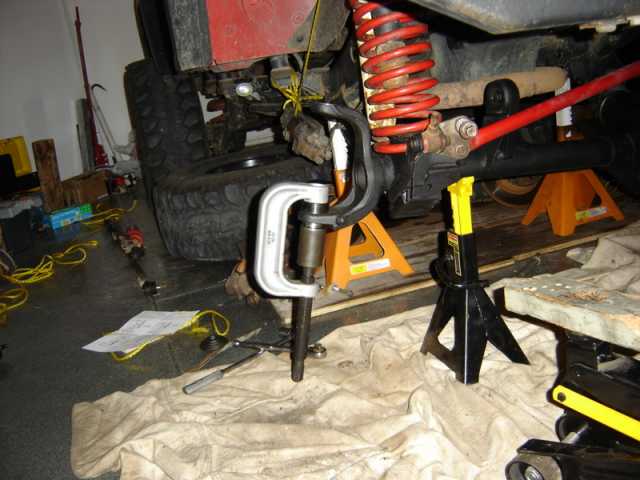
Tighten the press until the ball joint seats; you will probably need a breaker bar to fully seat it.


The lower ball joint is installed!
Now on to the upper, you are almost all done with one side!
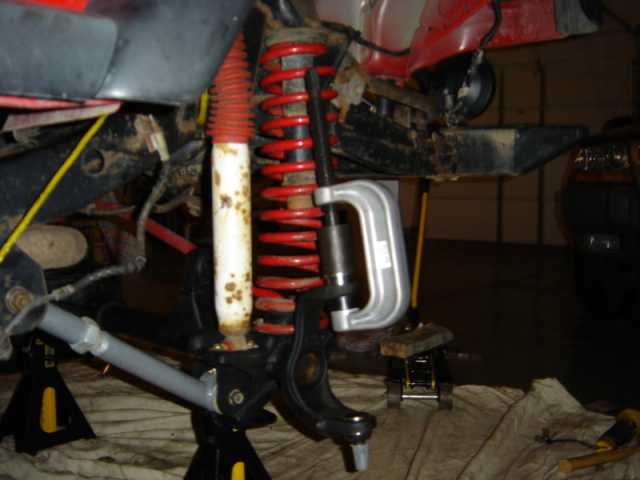
If you jacked up the axle to use the press as I did, you will need to lower the axle so the press fits in right side up. Do the same process as the lower; mock up the adapters and the ball joint so you know how it will fit.

Crank on the press just as before and then bust out the breaker bar for that last little bit. Fully seat the ball joint and then remove the press.
And there you have it, two new ball joints!
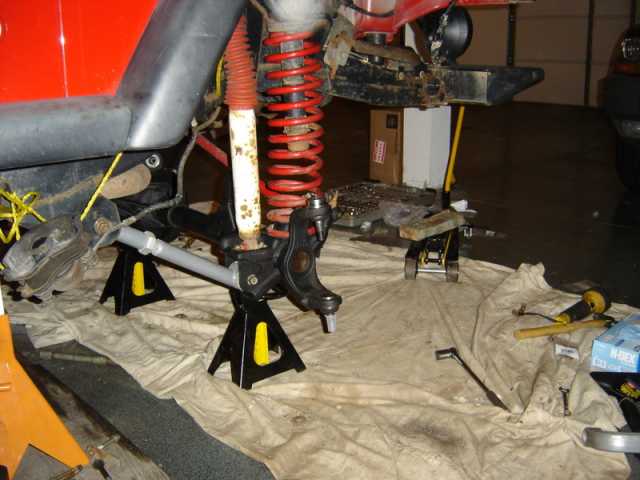
So, now you have some work to do before you go to the other side. If you are doing one at a time, you will need to re-install the knuckle. Simply put the knuckle into place and tighten the lower castle nut to 75 ft lbs. Then put the nut on the upper ball joint and tighten that to 70 ft lbs. Install the cotter pins and then put the TRE back on the steering arm. Tighten that castle nut to 35 ft. lbs. and install a new cotter pin. Apply some fresh grease to the splines of the axleshaft and where the seal rides and slide the axleshaft/hub assembly back into the housing. Don’t forget the dust shield or forget it, it doesn’t really matter. Tighten the three bolts from the back side of the knuckle to 75 ft. lbs. Slide the rotors on, install the calipers and tighten the caliper bolts to 11 ft. lbs. Put the tire back on and go do everything to the other side!
Wait, you aren’t done yet, you may need to reset your toe-in.
Ok, now you are done!
